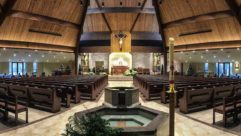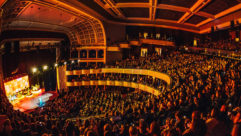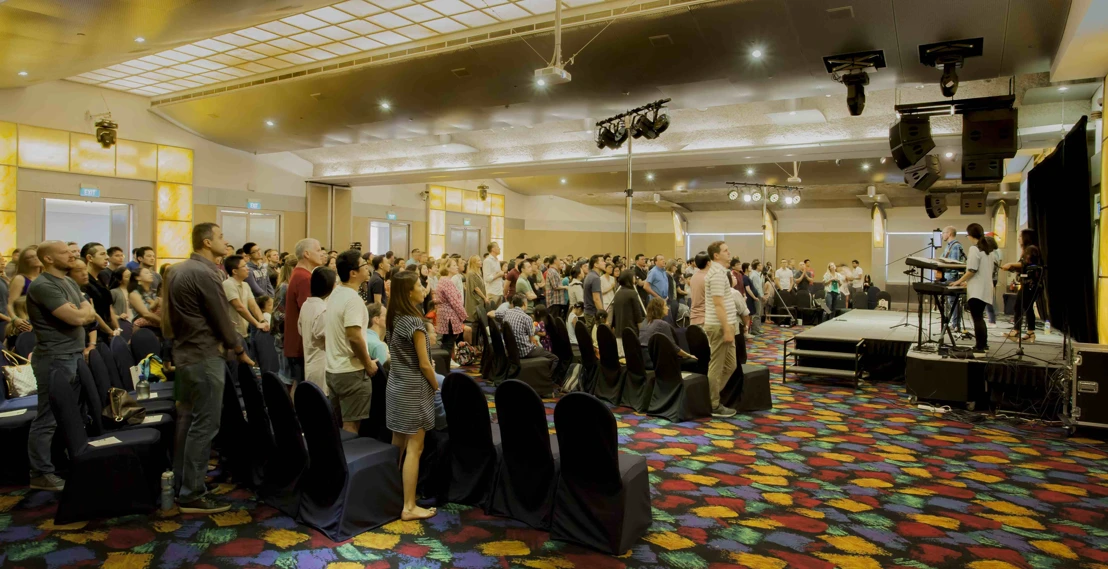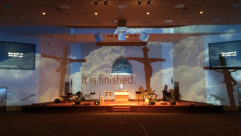Holy Family Church
Jan 1, 2001 12:00 PM,
By Joyce Jorgenson
The Great Chicago Fire of 1871 left only five public buildingsstanding in the city. One was the Holy Family Church, located onthe Windy City’s West Side, which went on to become the largestEnglish-speaking parish in the U.S. in the early 1900s. The houseof worship escaped destruction again in 1984 when the Holy FamilyPreservation Society was established to save the church from thewrecking ball and restore it to its original glory. Aided by“people, prayers and publicity,” the nonprofitorganization raised $4.5 million, $50,000 of which was contributedby local media celebrity Oprah Winfrey.
Administered by the Archdiocese of Chicago, Holy Family Churchwas built in 1857 and represents one of the best examples ofVictorian Gothic architecture in the country. Its 15,000square-foot interior provides 1,000 seats for services and has a65-foot ceiling throughout the sanctuary. The sanctuary iscruciform in design, having a south-to-north orientation, with themain altar located at the north end of the church.
Among its many notable features are the oldest stained glasswindows in Chicago and a world-class pipe organ purchased by theparish in 1870. The latter made the church a popular place formusical performances until the construction of Orchestra Hall in1984. Surprisingly enough, this vast space has always possessed aunique, warm sound that has won the hearts of many performers.
Jean Glockler, director of the Holy Family Preservation Society,has witnessed the entire restoration process while working closelywith architect Ward Miller of Chicago-based Vinci/Hamp, the firmcommissioned to manage the project in 1991. Throughout theendeavor, Miller has been responsible for both restoring HolyFamily’s authenticity and ensuring that the modernization of itsmechanical systems is done in accordance with aestheticrequirements. When the time arrived to locate a new audio system,Miller contacted Wizdum Audio, a local audio-visual firmspecializing in turnkey solutions for houses of worship for 18years.
Wizdum Audio Systems Engineer Greg Dieckhaus says that theoriginal system concept given to Wizdum by the church in 1993 wasdistributed in design and involved rigging loudspeakers withinornate hoop chandeliers mounted on pulleys, to be raised andlowered according to need. The plan, however, was ultimately placedon a back burner because of more immediate aesthetic and financialpriorities. The church opened for its first Sunday Mass in 10 yearsin 1994 using a temporary — and very feedback-prone —P.A. setup with speakers on stands sitting along the aisles.
In 1998, architect Ward Miller asked Wizdum to take another lookat the space from a completely different perspective. Instead ofusing the church’s distributed approach, Miller suggested hidingloudspeakers behind a skylight 65 feet directly above thetabernacle. The additional 20 feet of attic height above theskylight’s removable opaque panels, and the fact that it had beensealed off because of leakage when the roof was replaced, madeMiller’s plan not only doable, but aesthetically acceptable toeveryone concerned.
Once the decision was made to proceed with Miller’s plan, thenext question involved the loudspeakers themselves. First, giventhe proximity of the proposed single-source system to the podiumand altar locations, Dieckhaus felt it was especially importantthat highly directional loudspeakers with tight dispersion patternsbe used to avoid potential feedback problems. To that end, heselected Renkus-Heinz CT6-44 3-way large-format loudspeakers withlong-throw performance characteristics for the main speaker system,and a small number of compact Renkus-Heinz SR-81 and SR-61 2-wayloudspeakers for supplementary sound reinforcement in other areasthroughout the church.
Making the system easy to control — yet tamperproof— was another priority. Helping Dieckhaus to achieve thesegoals, while also providing a variety of other useful functions,were components from Biamp Systems: a Biamp VRAMeq VariableResource Auto-mixer and a pair of MSP22e multifunction systemprocessors. Together, these devices allowed him to create acost-effective solution using a Xantech Model 598-00 keypad tobring up the proper sound needed for any event.
Wall-mounted in a room adjacent to the sanctuary, the Xantechkeypad includes a master power switch and eight keys formanipulating the sound system. From the keypad, a system operatorcan adjust master volume up or down, music volume up or down (formusic playback) or choose from two presets. Preset one is a“Loud Mass” position, which provides increased volumeand a slightly different EQ curve for a full-house worship serviceor a large wedding. Preset two is used for events with fewerpeople, such as weekly masses and smaller gatherings.
The logic connections on the back panel of the VRAMeq providecontact closures capable of activating any of the automixer’sfunctions. These closures, when accessed via the Xantech keypad,interact with Biamp-supplied software, which in turn instructs theVRAMeq what command to automatically carry out. “I was reallystruck with the ease of establishing the keypad operations via theVRAMeq,” says Dieckhaus. “Biamp has really done theirhomework in creating an interface that allows you to do some fancykeypad operations without going through a lot of complicatedcomputer work.
“What initially drew us to the VRAMeq,” he furtherexplains, “was the fact that it has no control knobs on thefaceplate and fits in so well with our requirement that the systemessentially run itself with very little interaction. And byautomatically turning off unused microphones, it maximizes systemclarity and performance.”
The Windows-based VRAMeq is a 10-in/2-out programmable automaticmixer that includes 3-band equalization with variable mid-frequencycapabilities. Conversely, Biamp’s DSP-based MSP22e multifunctionprocessor provides gain management, equalization and delay, as wellas leveling, compression, limiting and soft-gating functions, plus1/3-octave and parametric equalizer sections with high-pass andlow-pass filters.
Each Renkus-Heinz CT6-44 loudspeaker combines a transducer withintegrated outputs of an 8-inch cone and a 1-inch compressiondriver with a 15-inch horn-loaded woofer. The speaker’s dispersionpattern is 40 by 40. The center, left and right speakers that makeup the main speaker array are mounted in the skylight 4 to 6 feetapart in a U-shaped configuration with the arch of the“U” facing the congregation. The left and rightloudspeaker arrays crossfire for complete coverage of the church’stransept areas while the center cluster provides sound to thesanctuary.
Rather than couple the loudspeakers to the building itself,Wizdum designed a special framework with flypoints which wouldallow them to suspend the speakers via aircraft cable to preventtheir bass energy from vibrating the building and creatingresonance problems. Since only three of the opaque panels weremoved to make way for the speakers, the speaker grille cloth wascolor-matched with the remaining panels.
Smaller Renkus-Heinz SR81 8-inch speakers were mounted high oneach transept wall to fire down on specific areas of side aisleswhich are blocked by columns. The SR81s are color-matched andhidden behind newly installed light fixtures. Two RH model SR616-inch speakers were cleverly disguised inside the tops of ornatelydecorated portable confessionals located on either side of the mainentryway under the balcony.
Wizdum installed a Shure MX412C high-sensitivity gooseneckmicrophone on the ambo podium (pulpit), and an Electro-VoiceRE-90BW boundary mic at the altar. The celebrant typically uses aShure UC14/93 UHF wireless lapel microphone. A wireless Shure Beta87 handheld wireless unit is used for speakers, musical soloists orcelebrants who wish to be more mobile during a service. Both micsystems operate on separate frequencies so they can be usedsimultaneously. Single microphone jackplates were installed at theambo podium and altar, while dual mic jackplates were installed oneither side of the altar platform, two of which are used full-timefor a pair of Audio-Technica AT851Rx microphones mounted in frontof choir pews adjacent to the tabernacle.
Microphone inputs are sent to channels 1 through 8 on theVRAMeq, with channels 9 and 10 reserved for a Denon DN-T620combination CD/cassette deck. For production capabilities, thechurch has a Mackie 16-channel console with microphone leveloutput.
The VRAMeq has two separate mix busses (mix-minus) which allowedDieckhaus to establish both a main mix to the P.A. system and anauxiliary mix for recording purposes. With the control software,the feed from each of the microphones can be individuallycalibrated for each of these mix busses. For instance, the choirmicrophone can be made louder on the recording feed than on theP.A. mix. This mix-minus connection also prevents a recording loopsince the playback deck output isn’t allowed to feed the input ofthe recording deck. Dieckhaus says this eliminates having toinstall a custom switch assembly (play/record switch) as asafeguard so that a person doesn’t inadvertently put the tape deckinto record mode while the playback connection to the tape deck isactive, causing a feedback loop.
The main mix of the VRAMeq feeds the two dual-channel MSP22eunits. The first MSP22e has been programmed to provide a crossoverfor each Renkus-Heinz CT6-44’s horn/driver at the top of thecabinet, as well as low-frequency output for its bass driver. Sincethe CT6-44 is a 3-way loudspeaker with a built-in tweeter passivecrossover, it’s a 3-way that only needs to be bi-amped, nottri-amped.
A second MSP22e unit provides time delay and EQ to the SR-81wall-mounted speakers in the transept areas through channel 1,while channel 2 takes care of time delay and equalization of theSR-61 loudspeakers located in the entryway confessionals. One ofthe nice features of the MSP22e is that it performs its owncalculations for proper distance/delay settings, and has a2-channel mix-matrix and a special mono 2-way crossover.
“The unique thing about the Renkus-Heinz CT6-44loudspeaker is that it uses a concentric driver configuration,which gives you the best of both worlds,” explains Dieckhaus.“In years gone by, we would have used large-format horns witha single 4-inch driver on the back for mids and highs, and thenadded a woofer. While a 3- or 4-inch driver is very efficient inthe midrange because it’s large, it’s really too large to be a goodtreble producer. Which is why, when you go into a space and hearthese old 2-way P.A. clusters, they have a very generic quality tothem and not a lot of sparkle.”
The concentric driver of the CT6-44 has an 8-inch midrangecoupled to a 1-inch tweeter element for extended high-frequencyresponse and is mounted on a specially designed horn. With anarrower 40 by 40 pattern, the horn provides tight pattern control.Within the Holy Family design, Dieckhaus used the CT6-44 toessentially beam the sound along highly specific pathways, whichavoided hitting the mics directly underneath them in the tabernaclearea.
To provide individual control of the CT6-44 speakers in the mainsystem, two separate Crest FA-1201, 450-watt (at 4 ohms) poweramplifiers were used. Additionally, a Crest FA-901, 225-watt poweramplifier drives the SR-81 speakers for each transept and theSR-61s in the entryway confessionals.
Dieckhaus says that although the large room is very lively, ithas some rather nice acoustical qualities that still draw manyChicago musicians who prefer to use the space for acousticconcerts. Since the new system was installed, the Music of theBaroque, a prominent Chicago group, has performed at Holy Family;and coming up in July, the Grant Park Festival Chorus will performtwo evenings of Rachmaninov’s Vespers. Dieckhaus attributes thefavorable acoustics to the church’s ornate interior, old-fashionedconstruction and the fact that “every nook and cranny hassome type of molding or carving, which keeps reflections atbay.” The only big acoustical problem, he notes, arereflections off the flat transept walls that extend the full65-foot height of the sanctuary. “But, unlike a lot ofcathedral-type churches,” he explains, “Holy Familydoesn’t have a droning reverb, just a nice, warm sound that adds aspecial ambience to the acoustical instruments onstage.
“With the pattern control of the main speakers, the bulkof the sound is highly directional and is put right down into thepews. And with the presets available, we’re not running the systemtoo loud, which is often a problem in a lot of big churches —they have the sound system calibrated only for when the sanctuaryis full. Then, during small weekday masses, it’s way too loud, andthe sound bounces around the room, resulting in very poor voiceintelligibility.”
Upon a visit to the church to hear how the system would actuallyperform during a large wedding, Dieckhaus says they were pleased tofind that it didn’t need a lot of heavy-handed tweaking. Heattributes that to several things, one being the system’s abilityto automatically turn microphones off when they’re not in use.This, combined with the excellent pattern control of theloudspeakers, the high-quality microphones and the overall soundquality of the audio products handpicked for the installation, allwent towards eliminating potential feedback.
“What adds to the simplicity in these types ofapplications is that we can very easily preset the system for theclient via our laptop on-site,” says Dieckhaus. “Oncethe system settings are established, the system doesn’t need acomputer interface to work all the time. We avoid systems thatrequire a full-time computer for these types of venues. At the sametime, if need be, it is easy to use any Windows-based PC loadedwith the Biamp software connected to the VRAMeq and MSP22e RS-232serial ports. Since both units pass audio right out of the box,they also provide a basic configuration that is more than adequateuntil the final tuning is performed.”
On-site installation of the sound system was a 2-part processheaded up by Wizdum’s journeyman technician Bill Burns. The firstphase, which took two weeks, was completed in November 1999 andincluded everything but the wireless microphone systems. In Aprilof this year, phase two involved replacing the church’s existingVHF wireless systems, which had to go due to the many interferenceproblems during Sunday worship services. Dieckhaus says that HolyFamily was not alone in this predicament — in Chicago, it’sbecome a serious problem for churches, who are all operating on thesame limited frequencies. Shifting to the premium multichannel UCseries from Shure and installing a Shure UA220 antenna distributionamplifier took care of the situation. The UA220 is stored alongwith all other system electronics in an equipment room adjacent tothe chancel area.
Dieckhaus says that the church was very helpful in providing acrew to assist them with the general pre-installation work, such asinstalling a new conduit system to support the system wiring. Whatturned out to be tougher than anticipated was the physical task ofplacing the speakers up in the attic space. Each box had to begingerly brought into position using winches and pulleys, all thewhile being extra careful not to disturb delicate pendant lightssuspended next to the skylight opening.
The Catholic Archdiocese of Chicago has been a client of WizdumAudio for many years, during which they’ve worked on literallydozens of churches throughout the city. Founded in 1982 by EdGomboz (also the principal of Audio Video Rentals by Wizdum Audio),Wizdum Audio has 20 people on staff dedicated to providing turnkeyaudio-visual solutions to houses of worship, educationalinstitutions, commercial businesses and theme parks. Dieckhaus saysthat Wizdum is a bit different than most since its sales engineersalso act as their own project managers, which has worked outbeautifully in making Wizdum a success.
“The whole importance of having the sound system in thechurch is to bring the word to the people,” says JeanGlockler. “Now when they come into a service or sit andlisten to a performance, they don’t think about where the sound iscoming from; they’re not distracted by speakers like you see in somany other churches. The clarity of the sound is wonderful. There’sno delay or reverberation, and we all found the simple controls andadjustments on the keypad to be the perfect solution. To sum it up,we love the way the system seamlessly applies 21st centurytechnology to this beautiful 19th century space.”
For More information
- Audio-Technica
www.audio-technica.com
Circle (121) on Reader Service Card - Biamp Systems
www.biamp.com
Circle (122) on Reader Service Card - Denon
www.del.denon.com
Circle (123) on Reader Service Card - Electro-Voice
www.electrovoice.com
Circle (124) on Reader Service Card - Mackie
www.mackie.com
Circle (125) on Reader Service Card - Renkus-Heinz
www.rh.com
Circle (126) on Reader Service Card - Shure
www.shure.com
Circle (127) on Reader Service Card - Xantech
www.xantech.com
Circle (128) on Reader Service Card










